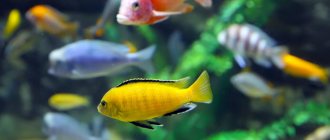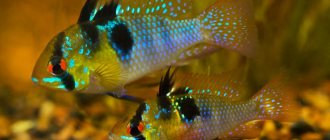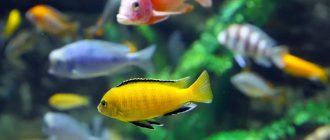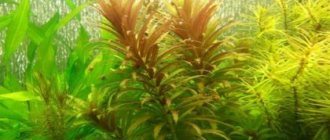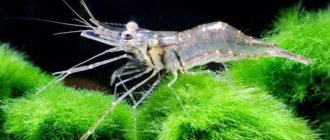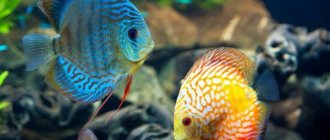5
(12)
In the world of aquariums, there is literally a whole army of fans of the cichlid family. Not surprising, because these are truly amazing animals, significantly different from other representatives of the underwater fauna in their color, habits and other features.
The most popular fish are Malawian cichlids. In terms of relevance, only astronotuses and parrots can compete with them. This demand is explained by the fact that these animals are not particularly whimsical, and thanks to their incredibly beautiful color they are able to decorate any aquarium.
Lake Malawi
Fish of the cichlid family (from the German “variegated perches”) are a fairly diverse group that unites both species of commercial importance and decorative specimens loved by aquarists. Cichlids are distributed in almost all corners of the earth, but of the 2-3 thousand species known to science, almost half live in two African lakes, Malawi (Nyasa) and Tanganyika.
The amazingly beautiful Lake Malawi is home to more than 500 species of fish.
Lake Malawi is a body of water formed when water fills a crack in a tectonic plate fault. In depth it is second only to two lakes: Baikal and Tanganyika. This lake was first found and discovered in 1859 by Scottish explorer David Livingston. Now the border of three East African states passes through the reservoir: Tanzania, Malawi, Mozambique.
There is a theory that the ancestors of cichlids were marine ray-finned fish, which, during the movement of tectonic plates, ended up in fresh water bodies. This explains the ability of some species to live in water with high salt content. Just one species, being isolated, over several hundred thousand years evolved into 500 new species, the formation of which continues to this day.
Most Malawian cichlids are found only in Lake Malawi, all the inhabitants of which can be divided into two main species - mbuna and utaka.
Mbuna
Small bright coastal fish with variegated colors, feeding mainly on algae, which they scrape from coastal rocks due to the special structure of their teeth;
Utaka
These are deep-sea predators that have more impressive sizes (up to 20 cm) and are distinguished by aggressive behavior; they feed on aquatic insects and small fish.
Almost all species of cichlids from Lake Malawi are united by reverent care for their offspring. The female incubates the fertilized eggs in her own mouth without eating for up to 30 days. Subsequently, when in danger, the fry hide in their mother’s mouth.
Places of residence
During the course of evolution, the cichlids of the lakes of Malawi were divided into two main ecological groups - the Mbuna and Utaka cichlids. "Mbuna" translated from the local dialect means "dwellers of the rocks" or "attacking rocks."
This name is associated with the place of residence and interesting social behavior of these fish, and also accurately reflects their lifestyle. In nature, this group of fish lives at various depths, in places with dense vegetation - on rocky areas of the bottom, along the coastline, reefs, islands, in crevices and sandbanks.
Males are equipped with grater teeth, which allow them to scrape plant matter from rocks, as well as defend and attack. This is the most numerous group, distinguished by territorial habits. Labidochromis, pseudotropheus, and melanochromis belong to the Mbuna group.
Video: history of the origin of Malawa cichlids
Among the prominent representatives of the Utaka group are Aulonocara, Cyrtocara, and Haplochromis. These fish are distinguished by their larger sizes and menu features. They prefer rocky bottoms where they can find live food.
Care and maintenance of Malawian cichlids
Since cichlids reach quite large sizes, the main requirement for their maintenance is the volume of the aquarium and the density of the individuals in it. These fish, depending on the species, can be kept in aquariums from 150 liters. Weekly you need to replace 30% of the water, using settled filtered water for filling.
The cichlid is full of colors, so despite the gloomy design it looks bright!
Sand or pebbles of medium and fine fraction are suitable as soil for cichlids. Most fish species like to burrow in the ground, so larger rocks can injure them.
Most representatives of this species can perceive plants as food, so in order to maintain a beautiful landscape, you should plant different types of Anubias. These plants have strong roots. tough leaves and stems.
Anubias is a hard-leaved aquatic plant that is good for cichlids.
Important content parameters are shown in the table below:
| Volume of water per 1 individual, l | Water temperature, °C | Water hardness, dGH | Water acidity, pH |
| 50-75 | 24-28 | 10-18 | 7,5-8.5 |
Food for cichlids should be selected depending on the species. Vegetarians can eat lettuce, seaweed, spinach, scalded nettle, and predators can be fed minced seafood.
Nutrition
Mbuna and Utaka cichlids differ mainly in their feeding habits. Mbuna's menu includes mostly plant food. Representatives of this group feed on algae, cutting them off with incisors from the surfaces of stones or rocks. These herbivores have an oral structure suitable for such a process.
Siamese algae eater, water axolotl, brocade catfish, clown fish, labidochromis yellow, and catfish Otocinclus affinis are also not against eating algae.
At the same time, young Mbuns can feed on zooplankton, but later their body certainly requires plant food. If these fish are offered live food uncontrollably, they will soon gain excess weight and lose their ability to reproduce.
Aquarium fish can be given various types of flakes or granular food. Mbuns will also enjoy chopped burdock, dandelion, and plantain with appetite. But representatives of the Utaka group, on the contrary, prefer live food and can even hunt their relatives.
In nature, these Malawians eat small zoo- and phytoplankton, as well as insects, eggs and fry - that is, almost everything that comes their way.
Since Ducks adapt well to any type of food, you can prepare many foods for them yourself. These fish will like bloodworms, daphnia and koretra. In addition, minced seafood, pre-gelled and frozen in parts, would be a good option.
Popular types
Malawians are loved by aquarists for their variegated coloration, like the inhabitants of the southern seas, in which almost all the colors of the rainbow are found. The fish are ideal for creating a pseudo-sea in an aquarium. In addition, they are long-lived in captivity. In suitable conditions they can live up to 8-12 years.
Among the popular ornamental species of these fish are:
Blue dolphin
In appearance it resembles a marine mammal due to the fatty bump on its head. Has a bright blue color. The body length can reach up to 25 cm in length. Unlike other members of the family, blue dolphins are very shy.
Peacock cichlids or Aulunocar
They grow up to 8-20 cm depending on the species. Their peculiarity lies in the fact that unsightly gray male fry, as they grow older, radically change color to blue or blue with a metallic tint. The fins are colored yellow, blue or blue, and the anal fin has yellow or orange spots.
Melanochromis
Males of this species grow up to 11 cm, and females are slightly smaller. The color of the fish is yellow or blue with dark longitudinal stripes along the entire body. These are the most aggressive representatives of the Malawians.
Labidochromis Yellow
A bright yellow fish with dark edging on its fins that grows up to 10 cm. It can be called the most peaceful among cichlids, since it gets along well with other medium-sized fish. Labidochromis Yellow breeds well in community aquariums.
Pseudotropheus
A popular group of cichlids with a variety of shapes and colors. The fish come in red, blue, yellow and other colors with or without dark stripes on the body. It is better to keep pseudotropheus in a species aquarium.
The brightest and most colorful cichlids in Africa
It is difficult to single out any individual species from the diversity. However, some cichlids have earned a special place in the hearts of aquarists due to their bright, contrasting colors and unusual shapes.
Dolphin blue
The large Malawian cichlid (up to 25cm) has a remarkable body shape with a large fatty growth on the forehead. Adults are colored a rich and pleasant blue.
Blue Pindani
Endemic to Malawi, belongs to the Mbuna group. The size of adult fish is 10-11cm. The body color is an even pale blue, with dark edging on the fins.
Red Kadango
Refers to the Malawian utaka. Large (up to 17cm) moderately aggressive fish. It has several morphs, but the most popular is the red one with a blue head and fins.
Haplochromis Livingston
Large (up to 25cm) species with a long body and large mouth. The color is silvery-yellow with dark spots unique to each individual throughout the body.
Labidochromis Hummingbird
A representative of the mbuna, it has several morphs, the most popular of which is yellow. Fish are quite peaceful, but cannot tolerate neighbors that are the same color as them. The size is only 10cm.
Bumblebee Cichlid
An uncooperative representative of the mbuna, 12-15 cm in size. The color is yellow, the fins are bluish. As a design - transverse black stripes. It gets very dark during the breeding season.
Lavender Mbuna
Grows up to 8cm. Color – rich orange and blue. Not too aggressive.
Dog cichlid
The color includes white, blue and yellow and several black stripes. Females are paler than males. Size – 10cm.
Malawi butterfly
Scientific name Aulonocara jacobfreibergi). Size up to 15-17cm. The orange-yellow coloring with pronounced stripes on the head and fins gradually turns into blue. Males are aggressive not only towards each other, but also towards fish with a similar color.
Aulonokara Nyasa
Queen among the Malawians. It has many bright morphs and is easy to select. Size 10-17cm. Females differ from males in their pale coloring.
Grant's Peacock
One of the most attractive morphs of Aulonocara. Males are very bright, blue-blue in color, with orange speckles. Females are inconspicuous, gray-brown, with pale stripes.
Compatibility
For cichlids, the issue of territory is one of the main ones. Even peace-loving representatives of Mbuna will rush into a fight for their “corner” with an opponent that is dominant in size, so their compatibility with other species needs to be given special attention.
The compatibility table clearly demonstrates the quarrelsome nature of African cichlids.
The ideal option would be a cichlid that contains a male and two or three females of the same species. If the aquarium is large enough, it is permissible to keep several groups, but females should predominate in them. For favorable coexistence between the two groups, it is necessary to provide shelters in which, if necessary, the fish can hide from each other.
The cichlid needs to be equipped with a sufficient number of shelters so that the playful neighbors can hide from each other!
Different types of cichlids of the same size get along well in one aquarium. There is no point in introducing residents of American lakes to Malawians. They are not compatible due to differences in feeding methods and water parameters.
Fish from Lake Malawi get along well with large catfish, shark barbs and adult labeos, but shrimp and small fish can easily become live food for them.
Description
Cichlids are divided into many species, differing from each other in size, body shape, color, and degree of aggressiveness towards other fish. All are united by belonging to the order Perciformes. The dorsal fins of Malawi fish are elongated and the rays are hard. The same applies to the anal fins. The color of the fish is very bright, the color palette is diverse.
Features of behavior
Malawian cichlids are active fish. They are constantly on the move, swimming around the entire aquarium, playing with each other, digging in the soil. They treat other fish that permanently live in the same territory with them with loyalty. Newcomers may be greeted aggressively and begin to chase them around the territory.
Newly acquired fish will most likely hide in hiding when they see a person. However, having gotten used to the new habitat, it soon begins to recognize the owner and, when he approaches the aquarium, swims towards him, begging for food.
Malawians are distinguished by their special attitude towards their offspring. Having laid eggs, fish carry them in their mouths, protecting them from enemies. The emerging fry can also hide in the throat pouch of their parents. In some species, only the female takes care of the babies, in others, both parents take care of them together.
Reproduction
All popular types of decorative cichlids reproduce easily in an aquarium. When favorable conditions are created, spontaneous spawning can occur, during which even the most peace-loving fish become aggressive, protecting their offspring.
05:14
Breeding cichlids in aquariums, tips and tricks.
Malawians lay eggs on any flat surface, be it a stone, a plant leaf or the glass of an aquarium. The female takes the fertilized eggs into her mouth, where she carries them for several weeks until they grow into full-fledged fry. To reduce the load on the female so that she can quickly produce new offspring, eggs can be grown in special incubators. However, there is a risk that during the collection of eggs, the female will swallow it!
Cannibalism often occurs among fry, so it is better not to allow fish of different sizes to be adjacent to each other, even within the same litter.
Why is Tanganyika a paradise for cichlids?
Lake Tanganyika is not just another African lake or even a very large body of water. Nowhere else in Africa, and perhaps in the world, is there a lake like this. Huge, deep, it lived in its own isolated world, in which evolution followed a special path.
Other lakes dried up and became covered with ice, but Tanganyika did not undergo any special changes. Fish, plants, and invertebrates adapted and occupied various niches in a special biotope.
It is not surprising that most of the fish living in the lake are endemic. About 200 species of different cichlids have been described so far, but every year new, previously unknown species are found in the lake.
Vast areas located in Tanzania and Zambia have not yet been explored due to the danger to life. According to rough estimates, the lake contains about a hundred species unknown to science, and of the known ones, about 95% live only in Tanganyika and nowhere else.
Diseases
If the appearance of the fish is alarming, and its behavior has changed, this may be due to one of the diseases that cichlids are susceptible to.
Fish diseases are most often caused by the following factors:
- injuries received during fights with neighbors in the aquarium or careless transportation;
- birth defects and anomalies;
- parasites and bacterial infections.
Diseases caused by poor diet or poor water parameters include Malawi disease, bug eye, and fin rot.
Various types of parasites are caused by ichthyophthyriosis, argulosis, hexamitosis, lernea, oodiniosis, and intestinal parasites.
A sick fish should be quarantined in a small separate aquarium, parasites removed, wounds treated with an antiseptic and kept separately using antibiotics. It is better to restart the general aquarium with complete cleaning of the soil, decor, and equipment.
Features of keeping at home
More than 600 species of cichlids are popular among aquarists, although even the largest and most aggressive representatives find their fans.
Aquarium requirements and external conditions
Cichlids require large volumes, and the most important thing is a large bottom area and space. It is necessary to conditionally divide the aquarium into parts with decorative items (driftwood, stones). But especially large species break decorations and can even break glass, so heavy objects should be secured carefully.
With rare exceptions, cichlids desperately dig the soil, which is why plants can only be planted with a strong root system, and then covered with stones (or in pots).
Cichlids will live long and please their owners only in clean water, so aeration and more powerful filtration will not hurt.
Nutrition
A balanced diet is the key to health, active behavior and an attractive appearance for “Africans”. Dry food should only be used from trusted manufacturers.
But they should be the basis of the diet; animal protein and natural herbal supplements are very necessary for fish:
- fresh greens (lettuce, dandelion, nettle, duckweed, etc.), thoroughly washed and scalded with boiling water;
- vegetables (cucumber, zucchini, bell pepper, pumpkin, etc.) – preferably lightly boiled;
- live food (tubifex, bloodworms) in limited quantities;
- fish fillet, squid, shrimp;
- a small amount of meat (lean varieties, beef heart), but this is not necessary (in nature it is rarely included in the diet of fish).
Why proper nutrition is so important: the intestinal structure of herbivores and carnivores is different. Predatory fish have a short digestive tract, and heavy protein foods do not stay in the body for a long time. Herbivores have a fairly long intestine, and animal food takes a long time to come out, so it can cause poisoning and bloating.
The proportions depend on the individual needs of the species. For example, the share of plant nutrition for cyphotilapia will be about 10%, for melanochromis - 80%. But cyphotelapians need large amounts of high-quality protein. Melanochromis also need it, but in a very small amount.
Diseases, their treatment and prevention
Most diseases of these fish begin with inappropriate or poor living conditions. African cichlids are quite tenacious and disease resistant. Most people tolerate medications well. But, like most hydrobionts, they are prone to infection by parasites, bacteria, fungi and other diseases.
For prevention, it is important to strictly follow simple rules:
- promptly treat injuries and their consequences;
- when purchasing new residents for a community aquarium, it is important to keep them in quarantine for a couple of weeks in a separate container (infection can enter the home pond with plants, poorly treated live food, or unboiled soil);
- do not allow an increase in the concentration of harmful substances in the water, which means making timely changes (25-30% of the volume per week);
- good aeration and filtration, regular bottom siphoning are required;
- proper and balanced nutrition, weekly fasting days (healthy fish should always be a little hungry);
- a quiet place for the aquarium to avoid constant stress for pets;
- maintaining optimal water parameters for each specific species (hardness, acidity, temperature, etc.), for this, only fish with similar requirements should be kept in one aquarium, and tests should always be ready to check.
We must not forget the two golden rules for aquarists - do not overfeed and do not allow overpopulation.
Reviews
The Malawian cichlid is a very beautiful and intelligent fish, but quite aggressive. We got two motley mbunas, but one beat the other to death and now she has been living alone for over a year. But it’s very interesting to watch her alone, how she jumps up when you approach the aquarium, dragging pebbles and melaniums)) Arina, 21 years old
I bought cichlids because I had liked them for a long time, but I had no idea that keeping them would be so difficult. First, they ate all the guppies in the common aquarium, and they had to be urgently removed. Later, another fact was discovered - they grow very quickly, so when they became cramped in a small aquarium, they returned to the pet store. For myself, I concluded: these fish are for large rooms and I don’t want to deal with them anymore! Evgeniy, 36, Ekaterinburg
At the pet store, I couldn’t take my eyes off the cichlids and bought myself pets of different shapes and colors. At first I fed them expensive food, but gradually switched to cheaper brands, and this did not affect their color or their health. In addition, they reproduce quite well, even too well for me! Lyudmila, 60 years old, Omsk
Character and habits
The behavior of cichlids from the African Great Lakes is so unique that it is attractive for study. By nature, these fish are sociable and active, in constant motion. The liveliness of individuals increases in accordance with the increase in the feeling of hunger.
Learn more about cichlid aquarium fish.
In pursuit of pieces of food, the greed and insatiability of these fish manifest themselves - real races are organized when the fish can instantly absorb everything that comes in its way.
Some species have very developed hunting instincts:
- Livingston's cichlid, burrowing into the sand, pretends to be dead, thus luring the victim;
- the red-tailed kadango, having a tube-shaped mouth, can easily suck in plankton like a vacuum pump;
- compresessips, having a narrow and flat body, is hardly noticeable to other inhabitants of the reservoir, which gives it the opportunity to quietly approach the victim.
Important! Due to the behavioral characteristics of Mbuna cichlids, these fish cannot be placed in cramped aquariums with few shelters.
Cichlids also stand out for their special intelligence. Domestic individuals recognize the owner and demonstrate developed social habits. Thus, almost all forms have parental care for the offspring. With a relatively small number of eggs laid, cichlids demonstrate a fairly high survival rate.
Video: keeping Malawian cichlids
This is explained by the original method of protecting larvae and fry: the female closely guards the eggs, carrying them in her mouth. And even the emerging fry at the time of any threat can hide in the throat of the parent.
Feeding Mbuna cichlids
The natural diet of cichlids from the Mbuna group is represented mainly by algae growing on rocks, as well as various invertebrates living in these foulings. This means that when keeping fish at home, you will need a special diet that will be rich in plant components.
Very often, Mbuna cichlids, considering them predators, are fed only with high-protein live or frozen food (for example, bloodworms). Unfortunately, this can cause a condition in fish known as Malawi bloat. It manifests itself in swelling of the body, protruding eyes, and hardening of the abdomen. In most cases, the fish die. It follows that plant foods play an extremely important role in maintaining the health of fish in this group.
The best option for feeding Malawi cichlids is high-quality dry food with the addition of algae. Especially for hobbyists, Tetra has developed a special food - Tetra Malawi. It is available in the form of flakes and granules and consists of 40% selected algae (spirulina, nori, chlorella), which fully satisfies the nutritional needs of herbivorous cichlids.
Tetra Cichlid Algae Mini food has good palatability. The green part of the nutritional balls is a concentrate of spirulina algae, which Mbuna cichlids need for comfortable digestion.
A good alternative would be TetraPro Algae chips, which also contain spirulina and are made using gentle technology that allows you to retain even more nutrients and vitamins.
